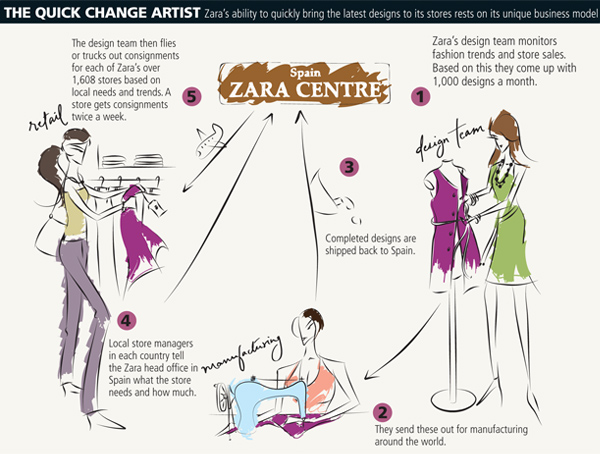Zara’s Supply Chain Strategies
“One day it’s in and the next day it’s out” – a popular phrase that often resounds when the apparel industry comes to mind. The fashion industry is known to run on a high degree of uncertainty. With ever changing trends it is even harder to predict the market and hence forecast the required raw materials and supplies. In the past the apparel industry has been categorized as more of a push model where the retailer outlets push styles and new outfits to the market.

However, the same strategy is doomed for failure as of today, with new entrants and competitors at every corner, brands are being forced to listen to their customer. It’s important to recognize what chimes with the consumer and quickly respond by satisfying this need. Additionally, every geographic location differs in spending patterns, styles, per capita income etc. and all the clothing lines need to accurately evaluate the demand that will exist in every market.
What increases the complexity of the supply chain is the dependence on exports from other developing countries. Almost 30% of all garments produced in the world are exported in developing nations. Hence, there is a large cost involved in transporting materials and finished goods.
Zara has maintained it’s stand as a leader in the apparel industry and what makes it so profitable is it’s unique supply chain strategies. Zara uses the following principles to increase their net income and maintain a standing of being a brand that is both fashion forward and affordable.
- Quick response to Demand – Zara follows a pull model in their inventory and supply chain management. They create up to 1000 designs every month based on store sales and current trends. They monitor customer spending’s in the store to evaluate and understand what types of designs are being consumed and then accordingly iterate on their next designs.
- Small Batch Productions – Zara has a fast turnover, they produce small number of quantities for every product. This gives them the opportunity to quickly understand what designs are successful. It is also a great way to explore new designs and understand its acceptance rate in the market. This also heavily reduces the risk of producing large quantities of something that the customer does not want. Even though it might seem like a bad idea to invest in different designs, Zara optimizes by using the same material only in different ways.
- Central Distribution Center – Zara has very strong IT systems that back it’s distribution. All the clothes are shipped back to Spain, the central location. From here, it is distributed to different countries and stores is based on individual requirements and needs of the particular locality.
Will Zara not feel threatened by the new entrants or old catching up and continue to practice it’s well tested and tried model, or will they be agile and innovate to sustain a competitive edge through supply chain?
Author: Manasvi Somaiya
Source: cmuscm.blogspot.se